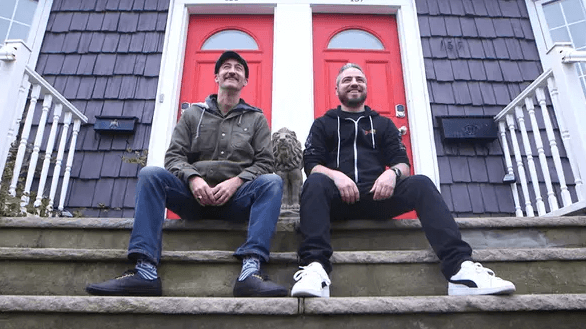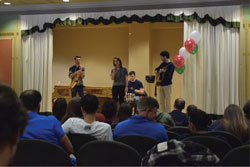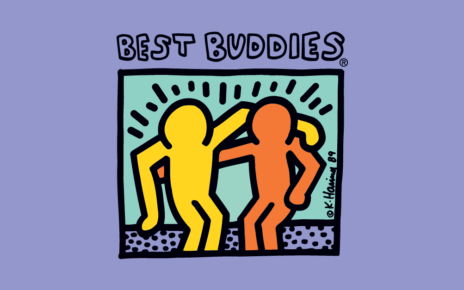Monmouth University’s ArtNOW visiting artist series hosted a presentation and workshop featuring the work of Anthony Jude Setaro and Douglas Booton on Tuesday, Oct. 4 and Wednesday, Oct. 5.
Setaro and Booton’s work revolves around immersive digital storytelling using 3D software to visually recreate Red Bank and Monmouth County in the early 1900s. They seek to explore the local history of their family emigrating from Italy, aiming to preserve their ancestors’ legacy and tell their story.
What originally started as a podcast and series of mini documentaries about their family history turned into a much larger project as the cousins took their story to Unreal Engine, a 3D computer graphics game engine developed by Epic Games that allows users to create photoreal visuals and immersive experiences.
Setaro and Booton’s research began after their aunt died in 2020, which led to the discovery of several artifacts in her house. These included old photo albums, postcards, clippings of news articles, and other relics that explained aspects of their family history and how it was deeply connected to the local Red Bank area.
The team’s first project in Unreal Engine was taking the postcards and photographs and putting them onto a map of Red Bank from 1889, figuring out where each photograph was taken and using that information to create a visual to understand what the town would have looked like back then. They focused primarily on recreating recognizable landmarks as the focal points of the map, and built the rest based off of that.
“[Unreal] enabled us to tell the full scale of this story,” said Setaro. “It’s never going to be completely accurate, but we wanted to get that feeling of the old Red Bank.”
The project was advanced even further when the cousins decided to expand their creation, expanding to capture the entire Monmouth County area rather than just Red Bank. Using geological surveys and topographical satellite data for accuracy, Setaro and Booton made a 400 square kilometer recreation of Monmouth County as it appeared in the early 1900s, completed with historically accurate characters and landmarks.
Moving forward, Setaro and Booton plan to incorporate live action shots into their Unreal Engine creation, create a feature film and streaming series, and eventually release a playable base level game as they continue to develop the project.
Setaro and Booton are not strangers to the Monmouth University community. Setaro is an alumni of the University and reached out to Aaron Furgason, Chair of the Department of Communication, to inform him of the project he and his cousin were working on.
“We got in touch and the two visited my graduate Message Construction class in the Spring because we were using a game engine software to create stories,” explained Amanda Stojanov, MFA, Assistant Professor of Digital Media. “They were able to present their work and their progress. From there, we continued working together to bring this event to campus and to show the students an even deeper picture into their entrepreneurial work with the immersive game engine and digital storytelling.”
“I took a class last semester where my professor had [Setaro and Booton] as special guests, which is where I first learned about their work,” said Skylar Smith, a graduate interactive digital media student. “My favorite part of this event was seeing their progress since I last saw it. Setaro and Booton are extremely passionate about their work, and their teamwork dynamics are admirable.”
“They visited the class while I was using Unity. They were using Unreal Engine, and there’s a longstanding debate about which is better,” Stojanov continued. “Through this experience, I’ve been able to learn some of what the Unreal Engine has to offer, and I started working with it over the summer when I was on sabbatical. Now, I’m teaching it in Interactive Media Productions to undergraduate students.”
Smith added that Unity and Unreal Engine are very similar programs and that she noticed a lot of parallels based on her work with Unity and seeing Setaro and Booton’s work with Unreal Engine, noting that she would eventually like to learn more about that software. “The small project I did took so much time and effort that doing something to the scale they are doing almost seems impossible. They learned how to do all of this in less than a year, which is crazy to me since it took me so long to create a simple 3D space [in Unity].”
Setaro and Booton’s work with Unreal Engine utilized data analytics and facial data capture to create augmented reality animation and video capture software that uses artificial intelligence to analyze movements from a video and create animations, two features that Stojanov said she would like to teach in her classes.
Following the presentation, Setaro and Booton hosted a workshop in the Interactive Digital Media Lab the next day. There, students were able to ask further questions and get a better look at the development of the game thus far.
This event was the latest installment of ArtNOW’s 2022-2023 theme “restorative relationships during precarious times.”
“Even just planning these events can feel pretty precarious based on our current situation in the pandemic. We thought that even though we’re still in precarious times, how can we come together as a community and create relationships and restore some of the old community storytelling events that we used to have so often,” said Stojanov.




